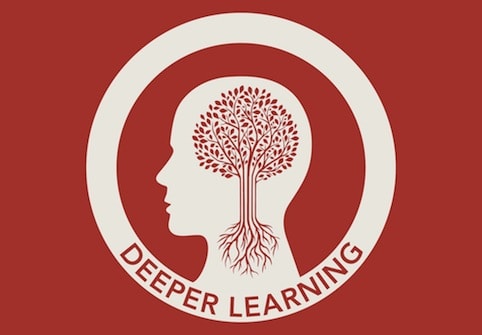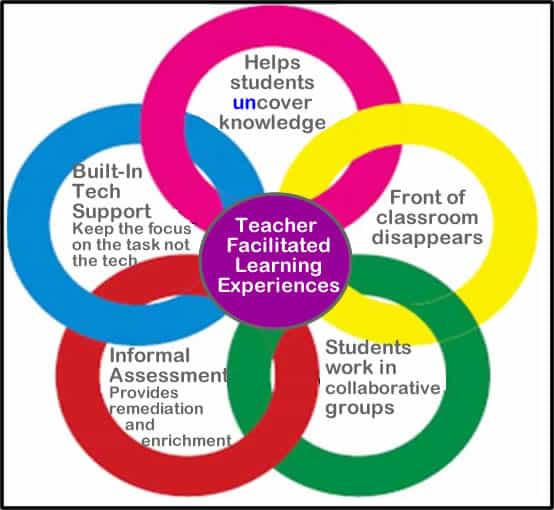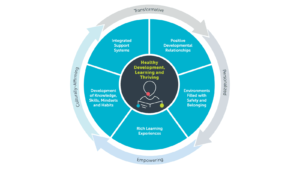5 Instructional Shifts to Promote Deep Learning

 Technology is a powerful tool for learning that can be used effectively to help students develop the skills necessary to succeed in school and beyond. Students can develop transferrable knowledge and skills as they engage in learning experiences that require them to construct knowledge. In order to facilitate these types of deep learning experiences, an adjustment in traditional instructional practices is necessary. These ideas are supported by the Common Core State Standards.
Technology is a powerful tool for learning that can be used effectively to help students develop the skills necessary to succeed in school and beyond. Students can develop transferrable knowledge and skills as they engage in learning experiences that require them to construct knowledge. In order to facilitate these types of deep learning experiences, an adjustment in traditional instructional practices is necessary. These ideas are supported by the Common Core State Standards.
The Common Core identifies a spiraling set of skills necessary to prepare students for success. The standards are designed to teach students how to think. They call for increased comprehension combined with the ability to clearly express learning. The seamless integration of technology into the Common Core-aligned curriculum supports learning through active participation and increases opportunities for all students to have access to the tools and information they need for success.
With increased Internet connected portable learning devices in our schools, access to information is readily available in a variety of formats and often in the palms of our students’ hands. While it’s safe to say that many schools are wired, it’s time to combine digital tools with innovative instructional practices to get our students plugged in. The strategies for teachers below support the idea of shifting instructional practices by using technology as a tool for learning rather than as an addition to a traditional unit of study.
Help students uncover knowledge
Instead of teaching scripted curriculum defined by a textbook, consider putting your teaching skills and expertise to better use during the instructional planning phase by designing Essential Questions to drive the learning. These Essential Questions should require students to construct knowledge and allow them to express their learning in original ways. There is no room for answers that simply require a copy and paste and worksheets become obsolete.
A good starting point for designing Essential Questions is to examine the required content and use Bloom’s as a guide to develop complex questions that require students to use higher level thinking skills to answer. Take a look at the Common Core and try to fit several of them into the process students will use to express learning. Make sure to dedicate an adequate amount of instructional time for students to answer this complex Essential Question.
Eliminate the front of the classroom
To fully engage students in the learning process; the focus of instruction must shift from the teacher in front of the classroom to the actively engaged student. The teacher’s role must shift from one who delivers content to one who facilitates learning, or serves as a guide on the side. This type of classroom is a busy, noisy and productive place where teachers interact with students to help them construct knowledge and, of course, the teachable moment comes alive. To extend the walls of the classroom, teachers can take advantage of online learning platforms to provide students with resources, feedback and the time they need to learn and create something original to express their learning, 24/7.
Encourage collaboration
Promote real world learning experiences and help students develop 21st century skills by encouraging collaboration. Let them discuss, present ideas, consider points of view and make decisions in order to increase their stakes in their own learning. Make it meaningful, personal and relevant and seek opportunities to collaborate with experts and other students across town or across the world.
Informally assess students
Make good use of the time you spend with students every day as a facilitator of learning by taking advantage of opportunities for informal assessment, and then pull together groups for re-teaching and challenge. In addition to observations and conversations in class, an online learning platform can provide students with 24/7 access to digital tools to connect with teachers and classmates for guidance and feedback. Use online discussion areas, electronic exit tickets, back channels and digital bulletin boards to encourage questions and reactions from all students. In addition, use frequent informal assessment to gauge the effectiveness of your instruction and make adjustments to maximize the learning experience for each student.
Design lessons with flexible learning paths
The concept of Universal Design for Learning suggests that teachers should design learning experiences to provide students with multiple means of engagement, representation and expression. Access to multimedia can provide students with flexible learning paths to meet many unique learning styles. Resources can include video, audio, text and images to provide students with information in a variety of flexible formats. Introduce students to digital tools with supports to meet their special learning needs and empower them to become independent learners. Choose learning platforms that provide students with opportunities to express their learning in a variety of ways and level the playing field for all learners.
Provide students with built in tech support
Create short and relevant screencast tech tip tutorials to provide students with instruction at the time they need it. Teach students to take advantage of the pause button to conquer learning at their own pace. Publish resources online for 24/7 supports. Instead of spending valuable instructional time teaching the same tech skills over and over again to individual students, just teach it once via a screencast and concentrate on the content.
An example of a 5th Grade Project
Essential Questions:
- What inspired the colonists to start a revolution?
- How and why did the colonists work together to overcome injustice?
- How did conflicts with Great Britain during Colonial times impact our lives today?
Student project:

Caption: This project was created with ThingLink.







Donna
These are wonderful ideas, and I think most educators would gladly incorporate these concepts into their classrooms if they knew how to put them into practice. How do these concepts work with students who have no experience with thinking critically? When I ask questions designed to encourage critical thinking, many of my students shrug their shoulders, and say, "I don't know.' One of the obstacles to their being able to understand and think on a deeper level is the lack of background information and experiences many of these kids have. How do you address this?
Replies
SusanOxnevad
You raise some good questions, Donna. The types of activities suggested here are designed to promote critical thinking because the learning is student-driven and fueled by Essential Questions that require students to interact with content. These types of learning experiences provide opportunities for students to decide for themselves what information is important to them which raises their own stakes in the learning process. As a facilitator of learning, teachers can spend valuable instructional time nurturing the development of critical thinking skills through interactions with students in place of traditional lectures. They can also extend the learning through online platforms. Teachers can use digital tools to guide the learning and help students build background knowledge by assembling packages of content that include multimedia resources and text at a variety of reading levels to meet individual learning needs, available 24/7.
Ken
Great post!
I'm wondering if the example of an essential question/project meets the criteria you've set above. Is there more to the project than creating the interactive poster - for example, a reflection on why they chose the videos/images/documents that they did and why they excluded others? It just seems like I have seen a lot of worksheets with that exact question (What inspired the colonists to start a revolution) and space for students to write down the answers that this student has provided visually. It seems like a more challenging essential question would be: "Was the American Revolution justifiable?" or something along those lines.
I'd be really interested to hear your thoughts on this. Thanks again for the post and I hope this comment is taken in the spirit it is offered: that of collegial learning, not criticism.
Replies
SusanOxnevad
I agree with you that a more powerful Essential Question could have been used in the example. My goal here was to include a very simple example so as not to overwhelm teachers considering implementing some of the instructional shifts suggested. On second thought, I'ved added a few more samples of Essential Questions that could be used to drive this Grade 5 learning activity. Thanks for your suggestion.
Robin
The 5 point diagram is visually strong and rich. A long time classroom MS science teacher with a project based program even pre -Internet days. I've always felt myself a "yearner" as defined by Seymour Papert. This year I am part -time, serving as a Citizen Science resource person for my independent school. Now with the free time to read,listen,share and reflect as never before About learning, I feel that my intuitions from the start were valid, but my follow-through was sketchy. For deep changes to take place ...a series of even 2 month internships at a self-selected(and justified) school, university, after school program...etc might be one way to enable them to happen. And not just as a one shot...but every 3-5 years. If the internships were along the line of exchanges - difficult, but possible in today's world - benefits would be even greater...and teaching could emerge as a far more fluid profession. At 66, still yearning to work for changes.
Replies
SusanOxnevad
Robyn, If deep changes are going to take place, professional development must be a big part of the equation. Thank you for sharing these great suggestions. You are indeed a life-long learner.
Cherie Garrett
Susan,
I totally agree that students need to use higher order thinking skills for their role in the 21st Century and to have a deeper understanding of content so they can synthesize new ideas and inventions. My concern with the project example provided is that is merely provides information to answer the essential questions. How can such a project prove student understanding AND demonstrate the student's ability to DO something with the content? This is the true point of learning in my eyes, and I hope to learn the answer in an iPad class that I am starting tomorrow.
Replies
SusanOxnevad
Cheri, In my experience, I've found that using complex essential questions that require students to construct knowledge in order to create something original leads to deep learning. The example included in the article required students to engage in research, use higher order thinking skills to analyze and synthesize information from multiple sources, and dig deep to present knowledge and ideas that go far beyond a basic level. This is very different from answering a simple "copy and paste" type question. Use of a rubric and a script for this project helped to target important learning goals and standards. I believe it is the process of constructing knowledge to create something original that leads to the deep learning, not the choice of end product or device.
Collaboration
Encouraging collaboration is essential! Collaboration is a life skill that needs to be taught. An essential skill!